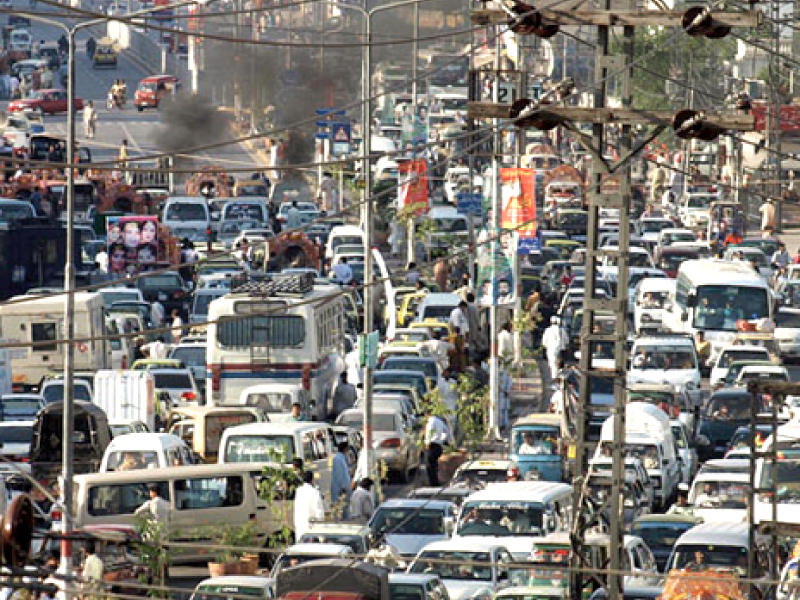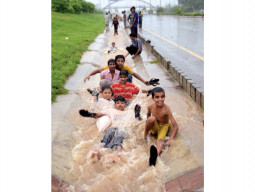
RAWALPINDI:
Chaotic scenes on Rawalpindi’s main roads remain a matter of routine despite several attempts by the city administration to fix the burgeoning problem.
The main arteries of the garrison city, particularly Benazir Bhutto and Mall Road, regularly witness massive traffic jams during peak hours that can force commuters to spend several hours on the road.
The traffic police, almost under attack by frustrated drivers, do their best to maintain smooth traffic flow, but are usually overwhelmed by the sheer number of vehicles, horses, donkeys and cattle.
“The issue cannot be resolved unless the traffic system is modernised and roads are remodeled,” suggested Asif, a traffic warden, while regulating vehicles near Committee Chowk.
Construction of flyovers
The recent construction of three flyovers on Rawalpindi’s busiest points costing billions of rupees has barely reduced traffic congestion. The previous PML-N provincial government constructed the Pirwadhai flyover at a cost of Rs1.447 billion, Sixth Road flyover for Rs1.042 billion and the Chandni Chowk flyover at a cost of Rs1.216 billion.
However, “Flyovers are not a practical solution for the problem. Instead, the government should have constructed underpasses as they facilitate traffic much better,” commented the warden.
Encroachments
Moreover, the large number of shops encroaching on public roads further adds to the traffic mess.
Showrooms for vehicles, roadside vendors, and unavailability of parking areas outsides plazas adjacent to main roads adds fuel to the fire that frequent traffic jams have become.
“Most buildings are erected in violation of building codes but no action is taken against the owners,” said a city administration officer, adding that none of the buildings have specific parking areas which are a must in the building by-laws. As a result, customers end up parking their vehicles on the roads, which effectively reduces the number of lanes available for traffic flow.
Encroachments are most rampant in Raja Bazaar, Waris Khan, College Chowk, Benazir Bhutto Road and Peshawar Road. “We conduct operations on a daily basis, but when we reach the designated areas, the vendors either run away or enter nearby shops,” said Rawal Town Spokesperson Muhammad Tahir.
Movement of VIPs and public demonstrations
The daily movement of VIPs and frequent protest demonstrations enhance the problems of commuters. “Protests on Benazir Bhutto Road occur regularly and force us to divert traffic to alternative roads, which can create bottlenecks due to the presence of encroachments,” said Traffic Police Spokesperson Wajid Satti. Similarly, the movement of senior government officials, both civilian and military, during rush hours further piles up the traffic mess on major roads. As a further multiplier, electricity loadshedding leads to the closure of traffic signals at some points which results in a free-for-all and needs to be manually regulated by traffic officials.
City Traffic Officer Syed Ishtiaq Shah, when contacted, termed encroachments, lack of road sense among drivers and an outdated traffic system as major causes of severe traffic jams in Rawalpindi.
“Removing encroachments is not the mandate of traffic police. I am sure if these encroachments are removed, 80 per cent of the city’s traffic problems can be solved,” he said, adding that blaming the traffic police for the problem is not fair.
Road rules?
“Lack of knowledge about road rules among drivers, especially traffic signals and rash driving are major causes of accidents which lead to traffic jams,” said Muhammad Ashfaq, another traffic warden.
“Government-run driving schools must follow strict syllabus and also test the attitude of potential licensed drivers before granting them the legal cover to be on the roads as most people are illiterate when it comes to the knowledge of basic road sense,” suggested Muhammad Iftikhar, an engineer by profession living in Dhoke Kala Khan.
Increasing number of vehicles, accidents
The recent rise in the number of vehicles, especially since car leasing was introduced, has led to a dramatic rise in the number of cars on the roads. Most people, who can afford it, prefer to have separate cars for all eligible family members as the government has failed to provide an efficient public transport system.
According to the Excise and Taxation Department, an average of 15,000 vehicles and 5,000 motorcycles are added to Rawalpindi’s roads every year. The data provided by the motor vehicle branch showed that 44,937 motorcycles and 25,744 vehicles have been added to the garrison city’s roads since 2007.
Published in The Express Tribune, August 19th, 2013.



































































COMMENTS
Comments are moderated and generally will be posted if they are on-topic and not abusive.
For more information, please see our Comments FAQ